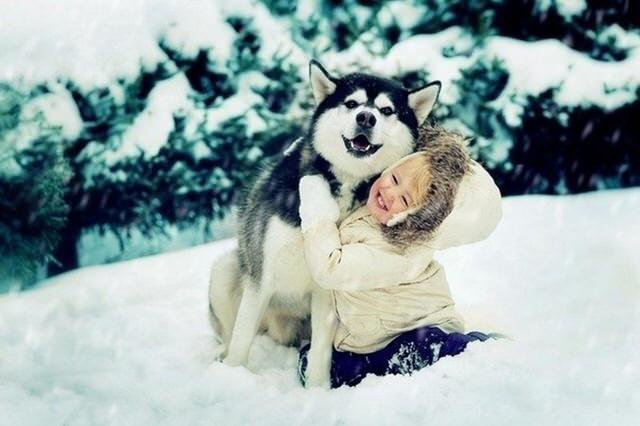Siberians and Children
Dogs of any breed have the potential to be both wonderful companions of children or horrific headline stories of injuries to children. Much of this is dependant on several factors including the presence or absence of parental supervision while children and dogs are together, the existence of an item of controversy such as a bone or toy, and the training, temperament, and tolerance level of the dog.
The Body Language Factor
 Dogs use body language to communicate with each other. They interpret our intentions from our body posture and eye contact. To a dog, these things are easy to read and understand. To humans, this ‘language’ is not always understood. Often small children have erratic behavior that is not predictable to the dogs. For some dogs this can result in being more defensive. Children may run, scream, and waive their hands, which may be perceived by a dog as litter mates wanting to play rough, prey, or a threat.
Dogs use body language to communicate with each other. They interpret our intentions from our body posture and eye contact. To a dog, these things are easy to read and understand. To humans, this ‘language’ is not always understood. Often small children have erratic behavior that is not predictable to the dogs. For some dogs this can result in being more defensive. Children may run, scream, and waive their hands, which may be perceived by a dog as litter mates wanting to play rough, prey, or a threat.
When children and dogs are together, it is important for the parent to watch the dog’s body language of the dog. This will assure that all involved will live in harmony.
The Tolerance Factor
Everyone has their limits – even the dog. Just think about a stressful day at work followed by a long drive in traffic only to come home to more frustrations at home. You try to get away and the phone keeps ringing, the kids keep bugging you, and so on until you yell – ’I need a break, leave me alone now!’ How much each of us can handle before we snap can vary. The same is true for dogs. Some seem to take anything, others just snap. It is important to know the tolerance of the dog in the presence of kids. This will help parents to know when it is best to keep the two separate and when they can be together in peace.
The Training and Conditioning Factor
As puppies, dogs learn how hard to play and bite at each other. Pups taken from the litter at too young of an age must rely on humans to teach this to them. Many people make the mistake of allowing pups to use their mouths in a manner that would be considered offensive to the litter mates. These pups may later grow up without the proper bite inhibition training.
How Rescue Matches Dogs with Kids
Dogs that are known to have a good history with children are permitted to be placed in families with kids or visiting kids. Dogs that have an unknown history require evaluation for tolerance and temperament to determine if they would present any risk to children. For the safety of all involved, the rescue volunteers tend to be conservative. However not every possible scenario can be tested prior to placement of the dog. Parents should be prepared to monitor the dog/child interaction for the first few weeks after the adoption. Rescue volunteers are available to discuss any potential issues or concerns new families may have.





